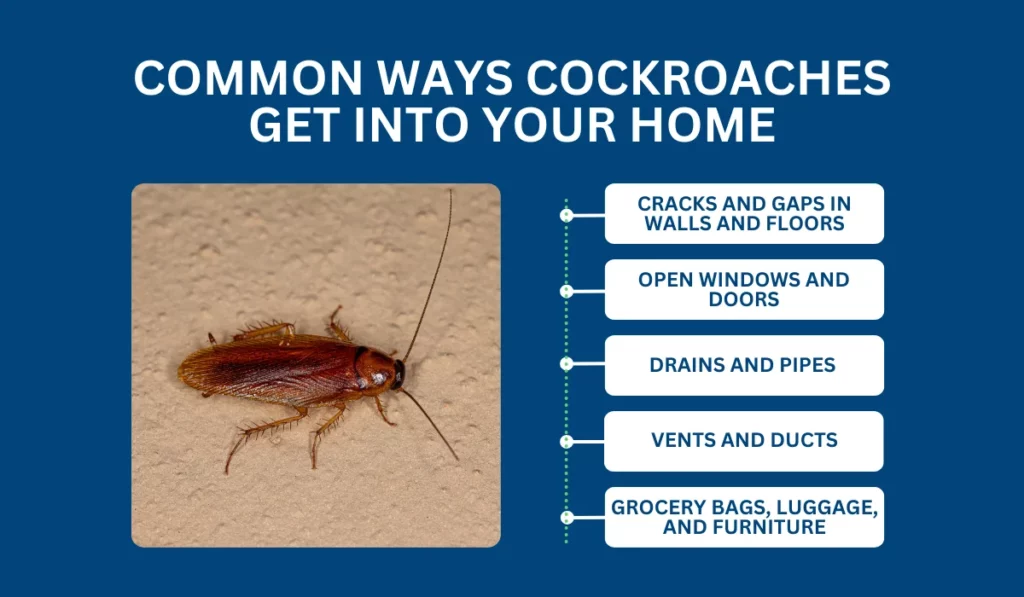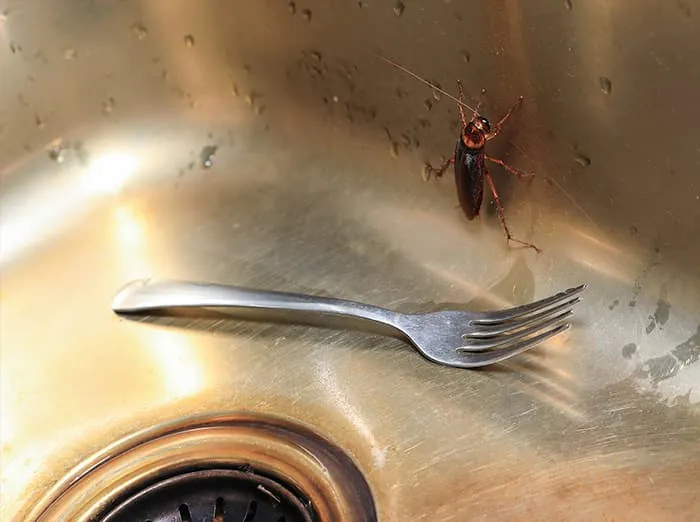Florida’s subtropical climate defined by year-round warmth, high humidity, and relatively mild winters provides cockroaches with ideal conditions to remain active and reproduce almost continually. In Port Charlotte, a popular community along Florida’s Gulf Coast, these resilient insects can slip into single-family residences, short-term rentals, or commercial properties if remnants of food, moisture, or accessible cracks present easy entry. Once inside, roaches often hide in dark crevices behind appliances, inside wall voids, or beneath baseboards. This page explains why cockroaches flourish in Florida, how to spot an infestation, and why calling a professional cockroach exterminator for cockroach treatments is the most thorough solution for creating and maintaining a roach-free environment.
Whether you oversee a single-family home in Port Charlotte or manage properties that also serve Englewood and Punta Gorda, discovering roaches early and employing specialized, multi-phase treatments helps occupants steer clear of potential bacterial contamination, occupant distress, and repeated do-it-yourself approaches that often fail to address hidden egg casings or deeply embedded roach nests within walls.
Why Cockroaches Thrive in Florida
Mild Winter Temperatures
In colder states, subfreezing winters significantly diminish or kill roach populations for long periods. Florida’s gentle cold season rarely dips below freezing, letting cockroaches feed, lay eggs, and mature nearly year-round. Climate-controlled interiors (about 65–85°F) eliminate any dormant period, encouraging rapid roach breeding unless occupant or property manager vigilance interrupts them.
Plentiful Food & Water Sources
Roaches devour almost any organic material kitchen scraps, pet kibble, or even leftover grease. In bustling Port Charlotte homes or hospitality units, occupant practices may inadvertently supply leftover crumbs if daily cleaning or disposal routines lag. Even modest water leaks under sinks or condensation from air conditioning lines can offer roaches the moisture they need to thrive in Florida’s humidity.
Quick Reproductive Cycles
A single female roach can carry multiple egg casings (oothecae), each containing numerous embryos that hatch within weeks. Overlooking initial roach sightings or minor droppings can spawn major colonies hidden behind walls or under cabinets if occupant or staff detection is minimal. In Florida’s year-round warmth, the eggs, nymphs, and adult roaches progress quickly unless occupant synergy or professional solutions halt them.
Varied Cockroach Species in Florida
Florida accommodates multiple cockroach species:
- German Cockroach: Smaller, rapidly breeding in kitchens and bathrooms.
- American (Palmetto) Cockroach: Larger, often nesting outdoors but invading indoors for food or cooler temperatures.
- Smoky Brown Cockroach: Prefers damp mulch or shrubbery around properties; occasionally slips inside for sustenance.
- Brown-Banded Cockroach: Occupies drier, higher spots like upper cabinets or inside electronics.
Each can survive indoors if occupant synergy (like sealing cracks and removing scraps) or specialized extermination doesn’t disrupt their lifecycle, especially in Florida’s mild winter climate that rarely slows roach reproduction.

Telltale Signs of a Cockroach Infestation
- Seeing Roaches, Especially During Daylight
- Roaches mainly hide in darkness, emerging by night. Spotting them under bright lights suggests a crowded nest forcing some out.
- Kitchens and bathrooms commonly reveal roaches scattering when lights turn on.
- Roaches mainly hide in darkness, emerging by night. Spotting them under bright lights suggests a crowded nest forcing some out.
- Droppings & Smear Marks
- German roach droppings appear as tiny black specks, like ground pepper; American roach feces are larger, cylindrical pellets.
- In humid corners, roaches may produce brownish smear marks on surfaces.
- German roach droppings appear as tiny black specks, like ground pepper; American roach feces are larger, cylindrical pellets.
- Egg Casings (Oothecae)
- Capsule-like containers carrying multiple embryos, typically found behind cabinets, under sinks, or near baseboards.
- Signals active roach breeding within your property.
- Capsule-like containers carrying multiple embryos, typically found behind cabinets, under sinks, or near baseboards.
- Musty, Oily Odors
- Substantial roach populations exude a foul, oily smell from droppings and bodily secretions.
- The stronger the odor, the more extensive or older the roach colony might be.
- Substantial roach populations exude a foul, oily smell from droppings and bodily secretions.
- Chewed Food Packaging
- Roaches gnaw cardboard, paper, or thin plastic to access stored edibles.
- Torn or ragged edges on pantry items confirm roach feeding activity.
- Roaches gnaw cardboard, paper, or thin plastic to access stored edibles.
- Occupant or Guest Reports
- In multi-unit or lodging properties condos, apartments, hotels occupant sightings of roaches can point to a bigger infiltration if occupant or staff housekeeping is partial.
- Rapid occupant or manager action keeps roaches from moving across occupant belongings or adjoining units.
- In multi-unit or lodging properties condos, apartments, hotels occupant sightings of roaches can point to a bigger infiltration if occupant or staff housekeeping is partial.
Why Overlooking Roaches Is Risky
Bacterial Contamination
Roaches forage in unsanitary spots like dumpsters or drains picking up pathogens (salmonella, E. coli) on their bodies. Indoors, they contaminate countertops, utensils, or stored foods with these bacteria, risking occupant illness.
Allergen Triggers
Cockroach excrement, saliva, and shed skins are allergenic, intensifying asthma or respiratory difficulties. Letting roaches reproduce unhampered accumulates droppings, raising allergen levels in occupant living areas.
Rapid Colony Growth
Females deposit multiple egg casings, each hatching many nymphs within weeks in Florida’s mild winters. Ignoring minimal droppings or occasional roach sightings frequently spawns robust colonies behind walls or hidden compartments if occupant or staff detection is delayed.
Occupant Stress & Negative Perceptions
Roach sightings undermine occupant assurance in property cleanliness particularly in short-term rentals near Englewood or Punta Gorda. Occupants encountering roaches might generate unfavorable reviews or occupant complaints if roaches remain unresolved.
Higher Treatment Costs
Minor roach populations found early can be addressed with moderate occupant disruption (targeted baits or partial spraying). Delaying until roaches saturate multiple rooms or floors forces repeated chemical treatments or occupant relocation, causing occupant irritation and bigger final bills.

Why a Professional Cockroach Exterminator Is Vital
Thorough Property Inspection
A cockroach exterminator thoroughly investigates wet corners, behind appliances, or along baseboards for roach droppings, egg casings, or smear marks. Confirming roach species German, American, smoky brown, or brown-banded clarifies whether the infestation is concentrated indoors or if perimeter coverage is essential for occupant peace.
Strategic Baiting & Spraying
Professionals place gel baits or bait stations in high-roach-traffic zones under sinks, behind stoves for slow-acting poison that roaches ingest and distribute back to nests. Residual sprays around baseboards or cracks kill roaches crossing treated surfaces afterward. This synergy outperforms occupant tries reliant on random aerosols or foggers missing deeper roach hideouts.
Insect Growth Regulators (IGRs)
IGRs inhibit roach nymph development, halting new egg production. Paired with adulticidal baits or sprays, they break the roach life cycle thoroughly. Occupant do-it-yourself approaches commonly skip nymph stages, letting roach populations rebound once adults die.
Controlled Chemical Usage
Inexpert occupant spraying can saturate occupant areas, threatening occupant or pet health. Exterminators apply insecticides selectively like dust in cracks or baits behind cabinets limiting occupant exposure. Gel baits remain discreet yet lethal to roaches, preserving occupant or pet safety.
Follow-Up & Prevention
Roach egg casings hatch weeks after occupant sightings end. Occupant synergy or second exterminator visits ensure newly hatched nymphs also encounter lethal solutions. Occupants receive housekeeping tips like storing leftover food properly or sealing leaks preventing roaches from reappearing in Florida’s mild winter environment.
Typical Methods for Cockroach Treatments
- Inspection & Roach Species Identification
- Technicians examine corners, damp areas, behind kitchen appliances, or inside cabinets for roach droppings, egg casings, or smear marks.
- Recognizing roach type (German vs. American, etc.) determines whether to prioritize kitchen/bath or building perimeter coverage for occupant well-being.
- Technicians examine corners, damp areas, behind kitchen appliances, or inside cabinets for roach droppings, egg casings, or smear marks.
- Gel Baits & Bait Stations
- Placed behind stoves, under sinks, or near corners, these slow-acting poisons lure roaches, who then distribute toxins back to nests.
- Colony collapse occurs as more roaches ingest the bait.
- Placed behind stoves, under sinks, or near corners, these slow-acting poisons lure roaches, who then distribute toxins back to nests.
- Residual Sprays & Dust
- Sprays around baseboards or cracks poison roaches crossing these zones after feeding.
- Dust extends lethal reach in deeper cavities or voids, out of occupant sight.
- Sprays around baseboards or cracks poison roaches crossing these zones after feeding.
- Insect Growth Regulators (IGRs)
- Prevent nymphs from maturing into egg-laying adults, halting the roach lifecycle long-term.
- Typically paired with adulticides for complete coverage.
- Prevent nymphs from maturing into egg-laying adults, halting the roach lifecycle long-term.
- Exclusion & Repairs
- Occupants or pros seal foundation cracks, mend door sweeps, or fill utility line gaps roaches use for entry.
- Removing dampness (fixing leaks) also denies roaches the moisture they depend on in Florida’s humidity.
- Occupants or pros seal foundation cracks, mend door sweeps, or fill utility line gaps roaches use for entry.
- Sanitation & Clutter Management
- Occupants discard leftover food daily, store items in sealed containers, or wipe counters diligently.
- Reducing cardboard or random clutter eliminates potential roach nesting corners behind stacked items.
- Occupants discard leftover food daily, store items in sealed containers, or wipe counters diligently.
- Maintenance & Follow-Up
- Roach egg casings may hatch weeks after occupant sightings vanish. Re-check occupant feedback or place sticky traps to detect new droppings or sightings.
- Roach egg casings may hatch weeks after occupant sightings vanish. Re-check occupant feedback or place sticky traps to detect new droppings or sightings.
Additional baits or occupant housekeeping finalizes occupant confidence that roach activity is thoroughly halted.

Service Areas: Port Charlotte, Englewood, Punta Gorda
While roaches adapt widely in Florida’s mild winter environment, this page focuses on Port Charlotte, plus Englewood and Punta Gorda, where occupant synergy alongside professional cockroach treatments remain indispensable to removing or preventing roach infestations. Florida’s gentle cold season seldom deters roach feeding or breeding, demanding occupant readiness and specialized extermination for thorough coverage.
Why Choose Us
Florida-Specific Strategies
We unite recognized roach control gel baits, insect growth regulators, crack-and-crevice dust along with occupant housekeeping shaped for Florida’s climate. Occupant synergy (like sealing leftover food, eliminating moisture) pairs with advanced exterminator coverage to outpace occupant do-it-yourself tries often missing deeper nest pockets or egg cases.
Detailed Property Examination
Before applying bait or insecticides, technicians carefully review kitchens, bathrooms, behind appliances, or baseboards for droppings, egg cases, or smear marks. Determining roach species German, American, smoky brown, etc. reveals if occupant synergy must focus on kitchen/bath or the property’s perimeter.
Safe & Targeted Product Use
Professionals place insecticides or dust strictly where roaches hide under cabinets, wall cracks, or baseboard edges rather than flooding occupant floors. Gel baits remain discreet yet lethal, minimizing occupant or pet chemical risk while effectively decimating roach colonies.
Preventative Guidance & Sanitation
Killing current roaches is half the equation. Occupants or pros seal foundation holes, remove leaks, or store leftover scraps in sealed bins, denying roaches future resources. This occupant-professional synergy cements roach freedom under Florida’s mild winter environment.
Follow-Up & Maintenance
Roach eggs can hatch weeks post occupant sightings vanish, delivering newly emerged nymphs. Many exterminators re-check occupant calls or propose second visits if droppings or sightings resume, refining occupant housekeeping or re-deploying baits until occupant confidence no roach pockets persist unseen.
Next Steps
Spotting roaches scatter when lights flicker on, discovering pepper-like droppings in cabinets, or noticing egg casings behind appliances? Contact us to learn more or schedule your service. Our cockroach treatments in Port Charlotte and also serving Englewood, Punta Gorda combine comprehensive property inspections, effectively placed baits or insecticidal dust, occupant-friendly sealing and cleanliness measures, plus vital follow-up eliminating roach infestations thoroughly and discouraging new arrivals.
Take decisive action to shield occupant health from roach-borne bacteria, maintain property cleanliness, and uphold occupant confidence if you run short-term rentals or multi-unit dwellings. Rely on our Florida-based cockroach exterminator know-how to locate, remove, and deter roaches effectively, overriding their mild winter breeding edge so occupant comfort endures all year.
